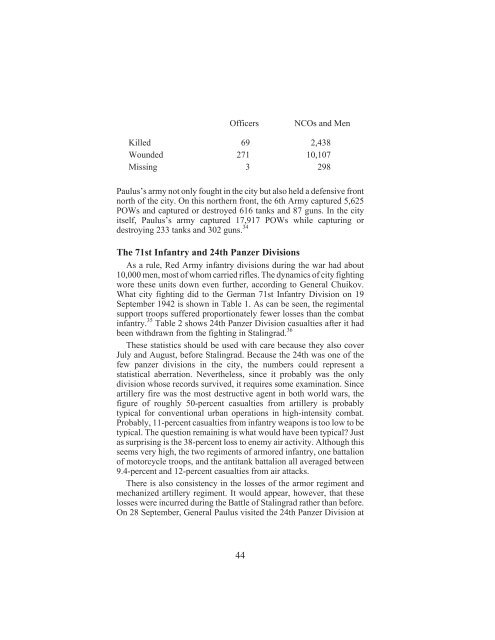SJ Lewis - Strategique.org
SJ Lewis - Strategique.org
SJ Lewis - Strategique.org
You also want an ePaper? Increase the reach of your titles
YUMPU automatically turns print PDFs into web optimized ePapers that Google loves.
Officers NCOs and Men<br />
Killed 69 2,438<br />
Wounded 271 10,107<br />
Missing 3 298<br />
Paulus’s army not only fought in the city but also held a defensive front<br />
north of the city. On this northern front, the 6th Army captured 5,625<br />
POWs and captured or destroyed 616 tanks and 87 guns. In the city<br />
itself, Paulus’s army captured 17,917 POWs while capturing or<br />
destroying 233 tanks and 302 guns. 34<br />
The 71st Infantry and 24th Panzer Divisions<br />
As a rule, Red Army infantry divisions during the war had about<br />
10,000 men, most of whom carried rifles. The dynamics of city fighting<br />
wore these units down even further, according to General Chuikov.<br />
What city fighting did to the German 71st Infantry Division on 19<br />
September 1942 is shown in Table 1. As can be seen, the regimental<br />
support troops suffered proportionately fewer losses than the combat<br />
infantry. 35 Table 2 shows 24th Panzer Division casualties after it had<br />
been withdrawn from the fighting in Stalingrad. 36<br />
These statistics should be used with care because they also cover<br />
July and August, before Stalingrad. Because the 24th was one of the<br />
few panzer divisions in the city, the numbers could represent a<br />
statistical aberration. Nevertheless, since it probably was the only<br />
division whose records survived, it requires some examination. Since<br />
artillery fire was the most destructive agent in both world wars, the<br />
figure of roughly 50-percent casualties from artillery is probably<br />
typical for conventional urban operations in high-intensity combat.<br />
Probably, 11-percent casualties from infantry weapons is too low to be<br />
typical. The question remaining is what would have been typical? Just<br />
as surprising is the 38-percent loss to enemy air activity. Although this<br />
seems very high, the two regiments of armored infantry, one battalion<br />
of motorcycle troops, and the antitank battalion all averaged between<br />
9.4-percent and 12-percent casualties from air attacks.<br />
There is also consistency in the losses of the armor regiment and<br />
mechanized artillery regiment. It would appear, however, that these<br />
losses were incurred during the Battle of Stalingrad rather than before.<br />
On 28 September, General Paulus visited the 24th Panzer Division at<br />
44


